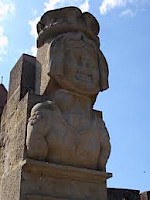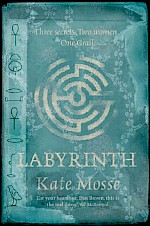‘Squeaky Carcas’
Working myself through the usual editing processes for a new issue – which, of course, requires a lot of reading and re-reading of all articles involved – I always find myself rooting for the Trencavel en Toulouse cause, despite the now all-too-apparent ending.
 My first real encounter with the Crusade and related events happened when I was fairly young, while reading a comic book of Suske en Wiske (Spike and Suzy in English, Willy and Wanda in the States, and Bob et Bobbette in French; fairly popular in The Netherlands, Belgium and France) called ‘De Krakende Carcas’ (which can be translated into something like ‘The Squeaky Carcas’; it sounds much better in Dutch, I can tell you). In it, our heroes are sent back in time – which happens quite a lot in the Suske en Wiske series; one of the benefits of having a genius professor-friend who can invent things like time machines; true story!* – to retrieve the escaped genie named Carcas. According to the local legend, this Carcas was a Moorish woman who successfully defended the castle against Charlemagne for quite some time by herself, though in the end she was defeated and cast out. After her death, she haunted the area and castle of Carcassonne in the Middle Ages. Our heroes, Suske en Wiske and their friends, arrive near Carcassonne, Southern France, during the time of the Albigensian Crusade. Amongst the many colourful characters present, a reader familiar with the history of the time will recognize Peter of Castelnau, legate of Pope Innocent III, Pope Innocent himself (with a nice reference to the wealth of popes at the time), Simon the Montfort (perhaps fittingly portrayed as somewhat of a violent madman, complete with wild and bushy tangly beard), the sometimes annoyingly good Raymond Roger Trencavel, viscount of Beziers and Carcassonne, and his son, the later Raymond II, who, in the comic book, is turned into a difficult to handle ADD child who looks way too old for the 2 or 4 years he actually was just before the siege of Carcassonne (still, if movies like Gladiator and Kingdom of Heaven can bend history to their own liking, why not a comic book) . And let’s not forget the Castle of Carcassonne, which has a prominent place within the story.
My first real encounter with the Crusade and related events happened when I was fairly young, while reading a comic book of Suske en Wiske (Spike and Suzy in English, Willy and Wanda in the States, and Bob et Bobbette in French; fairly popular in The Netherlands, Belgium and France) called ‘De Krakende Carcas’ (which can be translated into something like ‘The Squeaky Carcas’; it sounds much better in Dutch, I can tell you). In it, our heroes are sent back in time – which happens quite a lot in the Suske en Wiske series; one of the benefits of having a genius professor-friend who can invent things like time machines; true story!* – to retrieve the escaped genie named Carcas. According to the local legend, this Carcas was a Moorish woman who successfully defended the castle against Charlemagne for quite some time by herself, though in the end she was defeated and cast out. After her death, she haunted the area and castle of Carcassonne in the Middle Ages. Our heroes, Suske en Wiske and their friends, arrive near Carcassonne, Southern France, during the time of the Albigensian Crusade. Amongst the many colourful characters present, a reader familiar with the history of the time will recognize Peter of Castelnau, legate of Pope Innocent III, Pope Innocent himself (with a nice reference to the wealth of popes at the time), Simon the Montfort (perhaps fittingly portrayed as somewhat of a violent madman, complete with wild and bushy tangly beard), the sometimes annoyingly good Raymond Roger Trencavel, viscount of Beziers and Carcassonne, and his son, the later Raymond II, who, in the comic book, is turned into a difficult to handle ADD child who looks way too old for the 2 or 4 years he actually was just before the siege of Carcassonne (still, if movies like Gladiator and Kingdom of Heaven can bend history to their own liking, why not a comic book) . And let’s not forget the Castle of Carcassonne, which has a prominent place within the story.
The main story of the comic book focuses on a fictitious attack by Carcas and her straw soldiers (literally made of straw, by the way) on Carcassonne, and the defense by the local garrison, bolstered by Suske, Wiske and friends – their inhumanly strong friend Jerom (whose presence always removes any suspense, as he’s nearly invincible) having been conveniently whisked away by some Norse-like gods (who might even be introduced into the story for that very reason alone), after which he is taken aboard a spaceship and brought to Mars, only to crash-land back on earth at the very last minute to save the day; again: true story! During the story, we pick up some hints of the historical events at the time, including the fact that the local population mostly supported the Cathars, the mars of Simon on Beziers, and Raymond departing to gather support for his cause. The real siege of Carcassonne is only shown in one frame at the very end, when our friends return to their own time, only to find out that their 800-year old friend Raymond Roger died in captivity after the fall of Carcassonne.
 I’m sure you’ll understand that this volume was one of my favourite Suske en Wiske comic books. It had most of what a young man like me was looking for: knights, swords, castles, not-too-scary-and-human enemies, a proper historical background (with underneath it all the almost palpable threat of that mad-man Simon on his way to destroy ‘nice guy’ Raymond Roger and his people), some completely out-of-place mythology (but it was funny, so why not), and even some very limited science fiction. Naturally, just like every other reader, I was rooting nearly out loud for Raymond to win and survive, and I was relatively devastated (as any kid can be) when I read about his death. That said, except for the historical background and some colourful characters, the actual history was unrelated to the story, and so it provided me with a solid three quarters of an hour of good reading.
I’m sure you’ll understand that this volume was one of my favourite Suske en Wiske comic books. It had most of what a young man like me was looking for: knights, swords, castles, not-too-scary-and-human enemies, a proper historical background (with underneath it all the almost palpable threat of that mad-man Simon on his way to destroy ‘nice guy’ Raymond Roger and his people), some completely out-of-place mythology (but it was funny, so why not), and even some very limited science fiction. Naturally, just like every other reader, I was rooting nearly out loud for Raymond to win and survive, and I was relatively devastated (as any kid can be) when I read about his death. That said, except for the historical background and some colourful characters, the actual history was unrelated to the story, and so it provided me with a solid three quarters of an hour of good reading.
A little way further down the road, I came across the book Labyrinth, by Kate Moss, a sort of ‘Da Vinci Code’-like book of fiction, which is staged in the same Languedoc region in southern France. The background of the story is much more based on historical events (though it still clearly remains a work of fiction, with historical events still mostly providing the context). I’m pretty sure that Mrs. Moss has made a wise choice leaving out the Norse gods, Martians, and genies, but this is made up by its own share of mystery and mystification. I won’t bother you with the details, one the one hand because it takes too long to share the complete plot, on the other because I really wouldn’t want to give away what will happen (and to be honest, I really couldn’t recall all the details if my life depended on it; re-reading a comic book doesn’t take as long).
 The actual storyline aside, Labyrinth also provides the reader with a sort of insight into life in the Languedoc just before and during the Albigensian Crusade. I cannot recall the Cathar-issue being all that relevant, but the sense of danger and doom was surely present throughout the book (at least in those chapters which looked back 800 years), and it threw in knights, ladies, armed conflict, and Crusading into the equation, thus enabling the reading to immerse him- or herself into medieval (military) history. As with the comic book, Labyrinth also clearly takes sides, positioning Trencavel and his buddies as the tragic heroes against their will, and Simon de Montfort, the French crown and the Pope as rather evil bastards intent on stomping down any resistance against their dominance.
The actual storyline aside, Labyrinth also provides the reader with a sort of insight into life in the Languedoc just before and during the Albigensian Crusade. I cannot recall the Cathar-issue being all that relevant, but the sense of danger and doom was surely present throughout the book (at least in those chapters which looked back 800 years), and it threw in knights, ladies, armed conflict, and Crusading into the equation, thus enabling the reading to immerse him- or herself into medieval (military) history. As with the comic book, Labyrinth also clearly takes sides, positioning Trencavel and his buddies as the tragic heroes against their will, and Simon de Montfort, the French crown and the Pope as rather evil bastards intent on stomping down any resistance against their dominance.
Historical events dictate that any story against an Albigensian Crusade background, and with a clear Trencavel point of view, will end badly, but it’s still somewhat of a disappointment to hear of Carcassonne falling to the ‘evil’ Montfort, despite the fact that my historical education has taught me not to assign any modern morals to the not-so-recent past. I’ve been writing and editing about medieval military history for several years now, and I’ve been studying the past for even longer; I’ve been drilled into not routing for one historic side or another, and I’d like to think that I’m successful most of the time. But my Waterloo in this regards was, and still is, the Albigensian Crusade, compliments of the man who managed to combine military history, legend, mythology, science-fiction and a healthy dose of creativity and sometimes slapstick-like humor into a compelling story.
* To be fair, In ‘De Krakende Carcas’ they were transferred to the early 13th century via a warlock and his cauldron, not via time machine.

